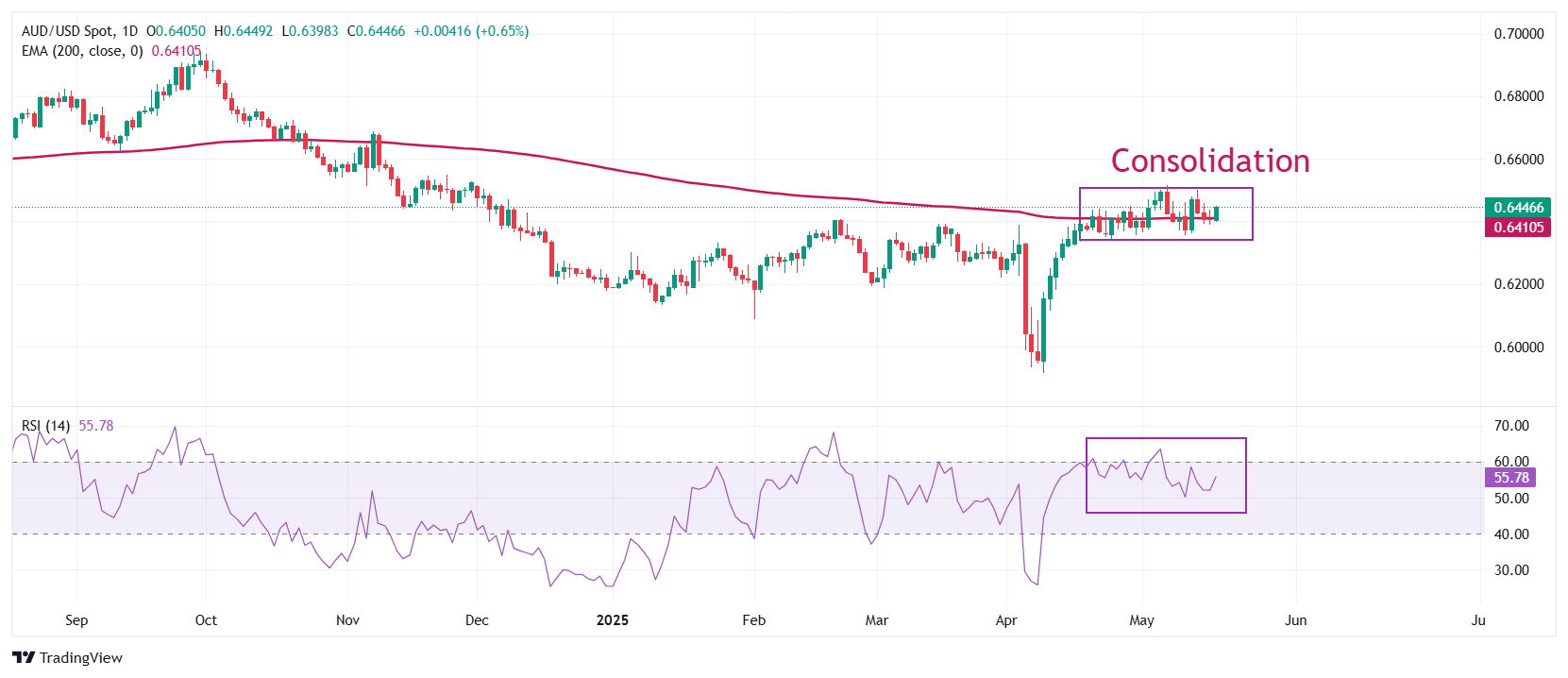AUD/USD Price Forecast: Jumps to near 0.6450 on US downgrade
- AUD/USD climbs to near 0.6450 due to a significant weakness in the US Dollar.
- Moody's downgraded the US long-term issuer and senior unsecured ratings of the US from Aaa to Aa1.
- Investors look for more evidence whether US President Trump will vist China for trade talks.
The AUD/USD pair gains sharply to near 0.6450 during European trading hours on Monday. The Aussie pair strengthens as the US Dollar (USD) underperforms after Moody’s downgraded the United States (US) Sovereign credit rating to Aa1 from Aaa in the wake of mounting debt levels.
The US Dollar Index (DXY), which tracks the Greenback’s value against six major currencies, plummets to near 100.20, the lowest level seen in a week.
US Dollar PRICE Today
The table below shows the percentage change of US Dollar (USD) against listed major currencies today. US Dollar was the strongest against the Canadian Dollar.
| USD | EUR | GBP | JPY | CAD | AUD | NZD | CHF | |
|---|---|---|---|---|---|---|---|---|
| USD | -1.07% | -0.80% | -0.36% | -0.16% | -0.62% | -0.53% | -0.50% | |
| EUR | 1.07% | 0.03% | 0.54% | 0.75% | 0.35% | 0.38% | 0.35% | |
| GBP | 0.80% | -0.03% | 0.21% | 0.73% | 0.33% | 0.34% | 0.33% | |
| JPY | 0.36% | -0.54% | -0.21% | 0.20% | -0.10% | 0.03% | -0.09% | |
| CAD | 0.16% | -0.75% | -0.73% | -0.20% | -0.45% | -0.36% | -0.40% | |
| AUD | 0.62% | -0.35% | -0.33% | 0.10% | 0.45% | 0.03% | 0.00% | |
| NZD | 0.53% | -0.38% | -0.34% | -0.03% | 0.36% | -0.03% | -0.03% | |
| CHF | 0.50% | -0.35% | -0.33% | 0.09% | 0.40% | -0.01% | 0.03% |
The heat map shows percentage changes of major currencies against each other. The base currency is picked from the left column, while the quote currency is picked from the top row. For example, if you pick the US Dollar from the left column and move along the horizontal line to the Japanese Yen, the percentage change displayed in the box will represent USD (base)/JPY (quote).
Meanwhile, US credit erosion has sparked bond yields. 10-year US Treasury yields surge to near 4.54%, with investors increasing risk premium.
On the Australia front, investors seek fresh cues on progress in trade talks between the US and China. Given that Australia relies heavily on its exports to Beijing, progress in US-China trade discussions is also favorable for the Australian Dollar (AUD).
Over the weekend, US President Donald Trump responded positively after he was asked in an interview with Fox News about whether he would visit China for direct trade talks with President Xi Jinping.
AUD/USD consolidates in a tight range of 0.6340-0.6515 for a month. The pair wobbles near the 20-day Exponential Moving Average (EMA) around 0.6410, indicating a sideways trend.
The 14-day Relative Strength Index (RSI) oscillates around 60.00. A fresh bullish momentum would emerge if the RSI breaks above that level.
More upside would appear towards the November 25 high of 0.6550 and the round-level resistance of 0.6600 if the pair if the pair breaks above the May 7 high of 0.6515.
On the flip side, a downside move below the March 4 low of 0.6187 towards the February low of 0.6087, followed by the psychological support of 0.6000.
AUD/USD daily chart

US Dollar FAQs
The US Dollar (USD) is the official currency of the United States of America, and the ‘de facto’ currency of a significant number of other countries where it is found in circulation alongside local notes. It is the most heavily traded currency in the world, accounting for over 88% of all global foreign exchange turnover, or an average of $6.6 trillion in transactions per day, according to data from 2022. Following the second world war, the USD took over from the British Pound as the world’s reserve currency. For most of its history, the US Dollar was backed by Gold, until the Bretton Woods Agreement in 1971 when the Gold Standard went away.
The most important single factor impacting on the value of the US Dollar is monetary policy, which is shaped by the Federal Reserve (Fed). The Fed has two mandates: to achieve price stability (control inflation) and foster full employment. Its primary tool to achieve these two goals is by adjusting interest rates. When prices are rising too quickly and inflation is above the Fed’s 2% target, the Fed will raise rates, which helps the USD value. When inflation falls below 2% or the Unemployment Rate is too high, the Fed may lower interest rates, which weighs on the Greenback.
In extreme situations, the Federal Reserve can also print more Dollars and enact quantitative easing (QE). QE is the process by which the Fed substantially increases the flow of credit in a stuck financial system. It is a non-standard policy measure used when credit has dried up because banks will not lend to each other (out of the fear of counterparty default). It is a last resort when simply lowering interest rates is unlikely to achieve the necessary result. It was the Fed’s weapon of choice to combat the credit crunch that occurred during the Great Financial Crisis in 2008. It involves the Fed printing more Dollars and using them to buy US government bonds predominantly from financial institutions. QE usually leads to a weaker US Dollar.
Quantitative tightening (QT) is the reverse process whereby the Federal Reserve stops buying bonds from financial institutions and does not reinvest the principal from the bonds it holds maturing in new purchases. It is usually positive for the US Dollar.


